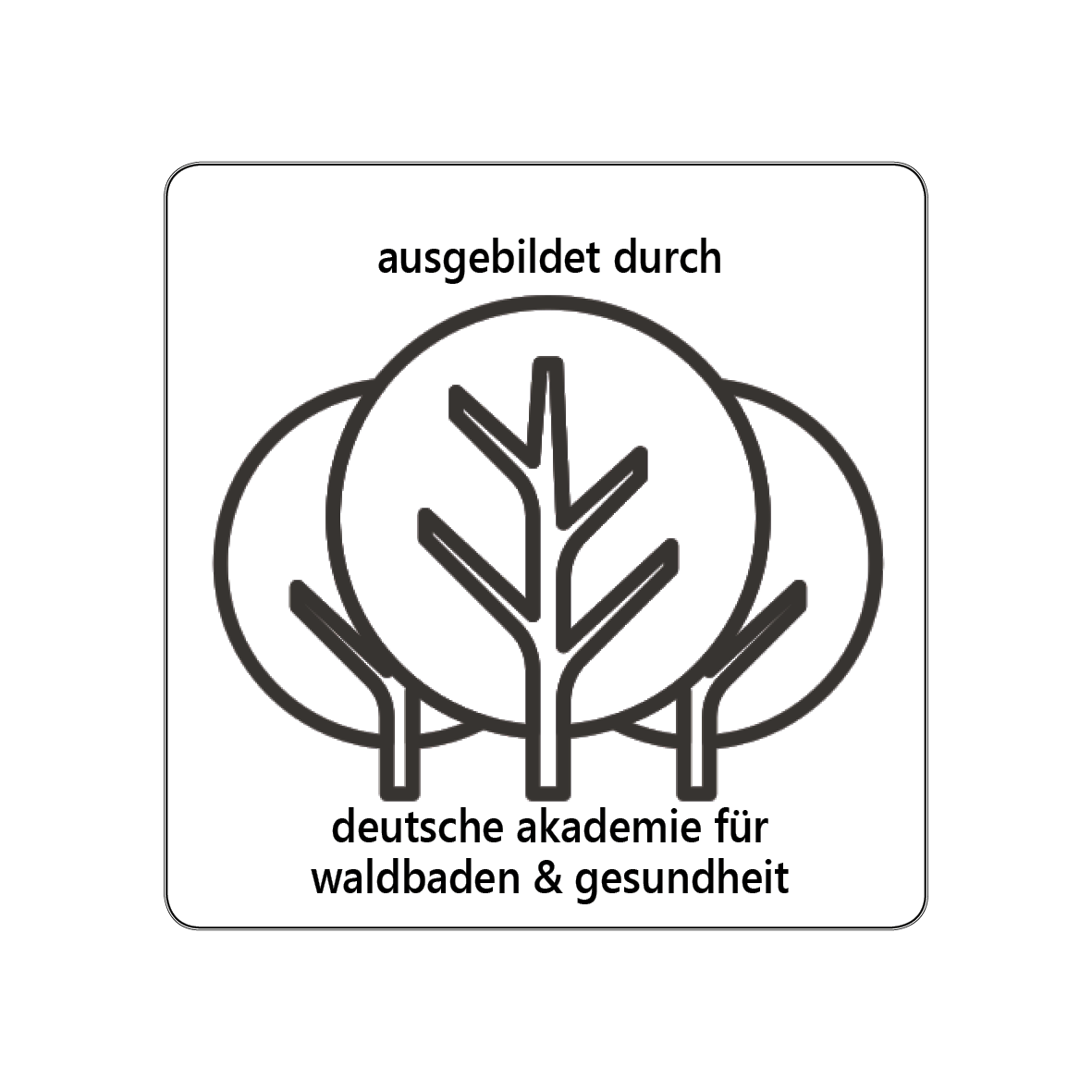Forestbound/
Waldwärts
Warum der Wald immer eine gute Idee ist!
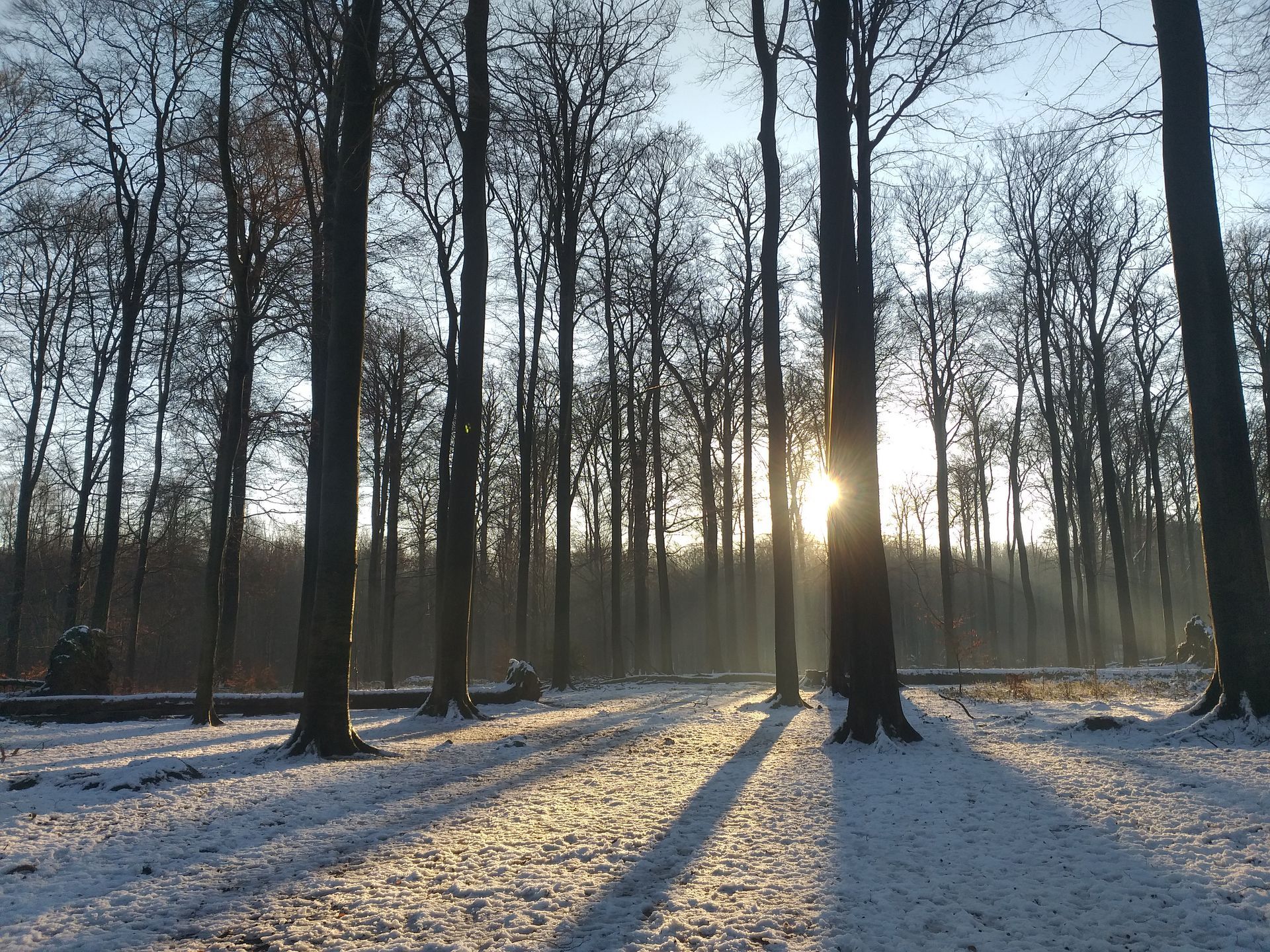
Ein ausgiebiger Spaziergang zwischen den Bäumen senkt Blutdruck, Pulsfrequenz und baut die Stresshormone Cortisol und Adrenalin im Blut ab, Entspannung stellt sich ein. Und…der Kopf wird frei, oft sieht man Dinge aus einer anderen Perspektive oder neue Ideen melden sich.
Studien aus Japan
zeigen, dass bei Männern nach zwei Tagen mit einem längeren Spaziergang im Wald der Adrenalinspiegel um 35 Prozent gesunken war. Bei Frauen sogar um 75 Prozent .
Woher kommt dieser Effekt? Chemie!
Der Mensch hat den Großteil seiner Evolutionsgeschichte in Wäldern verbracht und unser Gehirn, genauer gesagt, der älteste Teil unseres Gehirns, das limbische System, reagiert darauf jedes Mal dann, wenn er mit den biochemischen Substanzen des Waldes in Berührung kommt.
Diese biochemischen Substanzen, Terpene
genannt, finden sich in Blättern, Blüten und Früchten vieler Pflanzen, ebenso wie in der Waldluft und sind ein wesentlicher Bestandteil ätherischer Öle. Pflanzen und Bäumen dienen sie zur Kommunikation, beispielsweise bei der Abwehr von Schädlingen und zur Anlockung von Bestäubern. Sie wirken aber auch auf den menschlichen Organismus, insbesondere auf unser Immunsystem.
Zahlreiche Studien belegen diese bemerkenswerte Wirkung. So fanden z.B. japanische Forscher
an der Nippon Medical School heraus, dass bereits ein einziger Tag in einem Waldgebiet die Zahl unserer natürlichen Killerzellen (NK-Zellen) im Blut durchschnittlich um fast 40% steigert. Bei zwei aufeinanderfolgenden Tagen im Wald erhöht sich der Wert auf mehr als 50%. Dieser Effekt hält nach einem Waldaufenthalt von 2-3 Tagen für bis zu 30 Tage an .
Was sind natürliche Killerzellen?
Natürliche Killerzellen sind eine Form der weißen Blutkörperchen, die nicht nur Viren aus unserem Körper entfernen, sondern auch entartete Zellen, die zu Krebs führen können, bekämpfen. Atmen wir nun die in der Waldluft enthaltenen Terpene ein, steigt nicht nur die Anzahl der natürlichen Killerzellen in unserem Blut an, sondern auch ihre Aktivität. Somit spielen die in der Waldluft enthaltenen Terpene eine wichtige Rolle bei der Unterstützung unseres Immunsystems im Kampf gegen Viren und entartete Zellen*.
„Waldluft ist wie ein Heiltrunk zum Einatmen“, folgert denn auch Clemens G. Arvay, der in seinen lesenswerten Büchern „Der Biophilia Effekt“ und „Der Heilungscode der Natur“ ausführlich und wissenschaftlich fundiert beschreibt, welche chemischen Prozesse unser Immunsystem beim Waldaufenthalt beeinflussen und wie sehr der Mensch mit der natürlichen Umwelt verbunden und vernetzt ist.
Wald tut gut, immer und zu jeder Jahreszeit. Nicht nur seelisch, sondern auch auf körperlicher Ebene. Gehen Sie raus in die Natur. Ob bei einem Spaziergang oder bei einer Waldbadentour, wo sie die heilenden Kräfte der Natur noch intensiver erleben können. Ihr Körper und Geist werden es Ihnen danken.
*Es versteht sich an dieser Stelle von selbst, dass ein Spaziergang im Wald oder Waldbaden niemals ein Ersatz für schulmedizinische Behandlungen sein kann, sondern es sich lediglich um eine zusätzliche gesundheitsfördernde Maßnahme handelt.

Der goldene Oktober und Halloween sind vorbei, Weihnachten ist noch nicht da. Wir sind gerade irgendwo dazwischen - im November - und dieser Monat hat oft gar keinen guten Ruf – zu kalt, zu nass, zu dunkel. Dabei sind es oft Zwischenräume, die am interessantesten sind, weil sich dort etwas im Übergang befindet, ein Nebeneinander existiert, wo Raum ist, innezuhalten, zur Ruhe zu kommen, Stille zu genießen, bewusst wahrzunehmen, sich zu verbinden. In der Natur, besonders im Wald, erlebt man diesen Zwischenraum gerade sehr deutlich. Der Wald zeigt sich weiterhin in leuchtenden Herbstfarben, gleichzeitig werden die Baumkronen lichter. Während manche Blätter noch grün sind, werden andere schon von den Herbstwinden erfasst und sinken tanzend zu Boden, wo sie die Grundlage für Neues bilden. Während die Tage noch angenehm frisch sind, werden die Nächte oft schon empfindlich kalt, der erste Frost kommt zu Besuch. Das geschäftige Treiben der Eichhörnchen, die sich auf die kalte Jahreszeit vorbereiten trifft auf eine sich verlangsamende Natur. Der November hat etwas ganz Eigenes. Er lädt ein: zum Entschleunigen, zum Durchatmen, zum Innehalten. Zum Entdecken der Kraft und der Möglichkeiten, die in Zwischenräumen steckt. Gerade beim Waldbaden, bei dem wir uns achtsam und mit offenen Sinnen durch die Natur bewegen und uns ihr zuwenden, öffnet die Natur einen Raum, in dem Gedanken zur Ruhe kommen oder aus einer neuen Perspektive gesehen werden können, wo Neues entstehen darf, Stille genossen und gleichzeitig neue Kraft geschöpft werden kann. Wenn Sie im November im Wald unterwegs sind, nehmen Sie sich ein wenig Zeit, halten Sie inne, schauen Sie sich um, nehmen Sie die Schönheit und den Wandel des Waldes wahr: die unterschiedlichen Herbstfarben, das Rascheln des Laubes unter den Füssen, das zu neuem Boden wird, den Wind auf dem Gesicht, der zwar kalt aber auch belebend ist, oder das leuchtende Moos, das sich vom erdig braunen Waldboden abhebt. Spüren Sie hinein, in die Gegensätze, in das Nebeneinander, in die Zwischenräume, die die Natur vor uns ausbreitet und lassen Sie sich inspirieren!
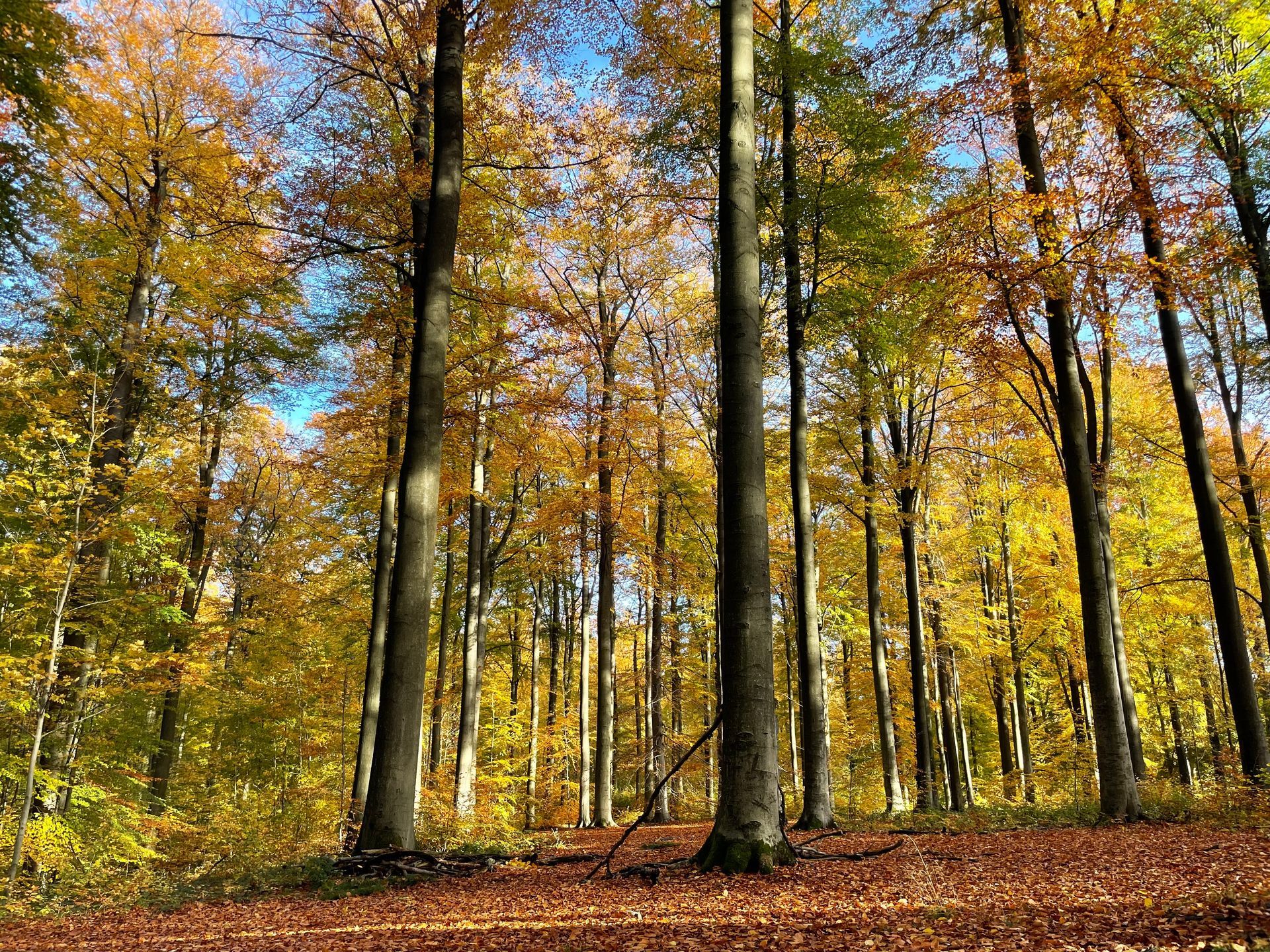
The golden October and Halloween are behind us, Christmas is not yet here. We find ourselves somewhere in between – in November – a month that often doesn’t have the best reputation: too cold, too wet, too dark. Yet, it is often these in-between spaces that are the most fascinating. They are places of transition, where opposites coexist; places that invite us to pause, to slow down, to embrace stillness, to become more aware, to reconnect. In nature, especially in the forest, this in-between state can be felt vividly now. The forest still glows with the vibrant colors of autumn, yet the treetops are already thinning. While some leaves are still green, others are caught by the autumn winds and drift gracefully to the ground, where they become the foundation for new life. Although the days are still pleasantly cool, the nights are already quite cold. The busy scurrying of squirrels preparing for winter meets a nature that is gradually slowing down. November has a unique character of its own. It invites us: to unwind, to breathe deeply, and to discover the strength and the possibilities that lie within the in-between spaces. Especially when forest bathing - moving mindfully and with open senses through nature - we enter a space where our thoughts can quiet down or gain new perspective; a space where something new can emerge, where we can savour stillness and draw renewed strength. When walking through the forest in November, take your time. Pause for a moment, look around, take in the beauty and transformation of the trees: the varied autumn colours, the rustling leaves underneath your feet, the wind on your face – cold, yet invigorating – or the vivid moss that stands out against the earthy brown forest floor. Tune in to the contrasts, the coexistence, the in-between spaces that nature unfolds before you – and let them inspire you.
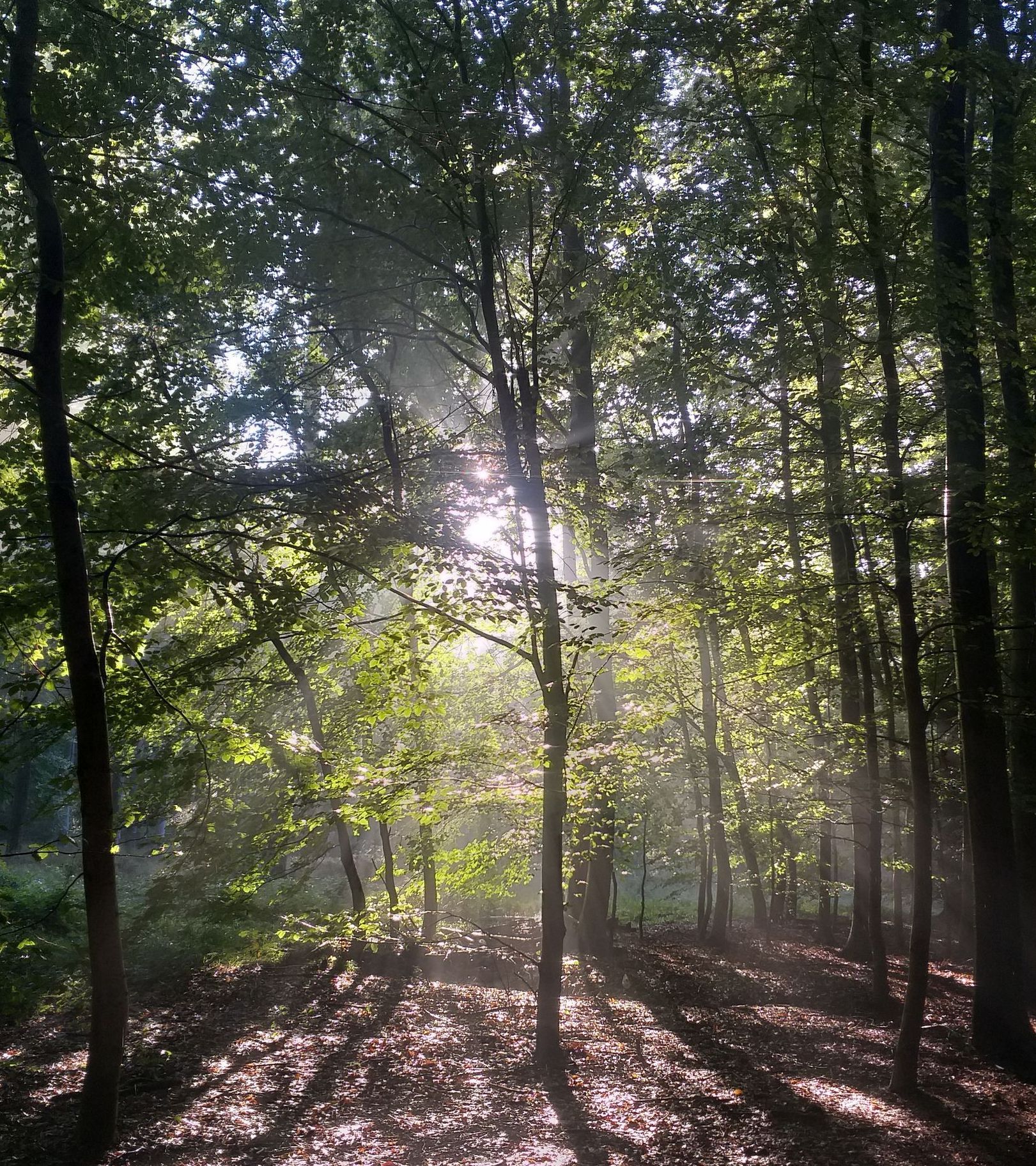
Wussten Sie, dass Bäume miteinander kommunizieren und welche Rolle Pilze bei dieser Kommunikation spielen? Dass Bäume nachts ihren Durchmesser ändern und dass eine Handvoll Walderde mehr Lebewesen enthält als es Menschen auf der Erde gibt? Erfahren Sie mehr über die Geheimnisse des Waldes in dieser faszinierenden Folge von Terra X History „Unsere Wälder“: https://www.youtube.com/watch?v=wXgvxooJaPE.
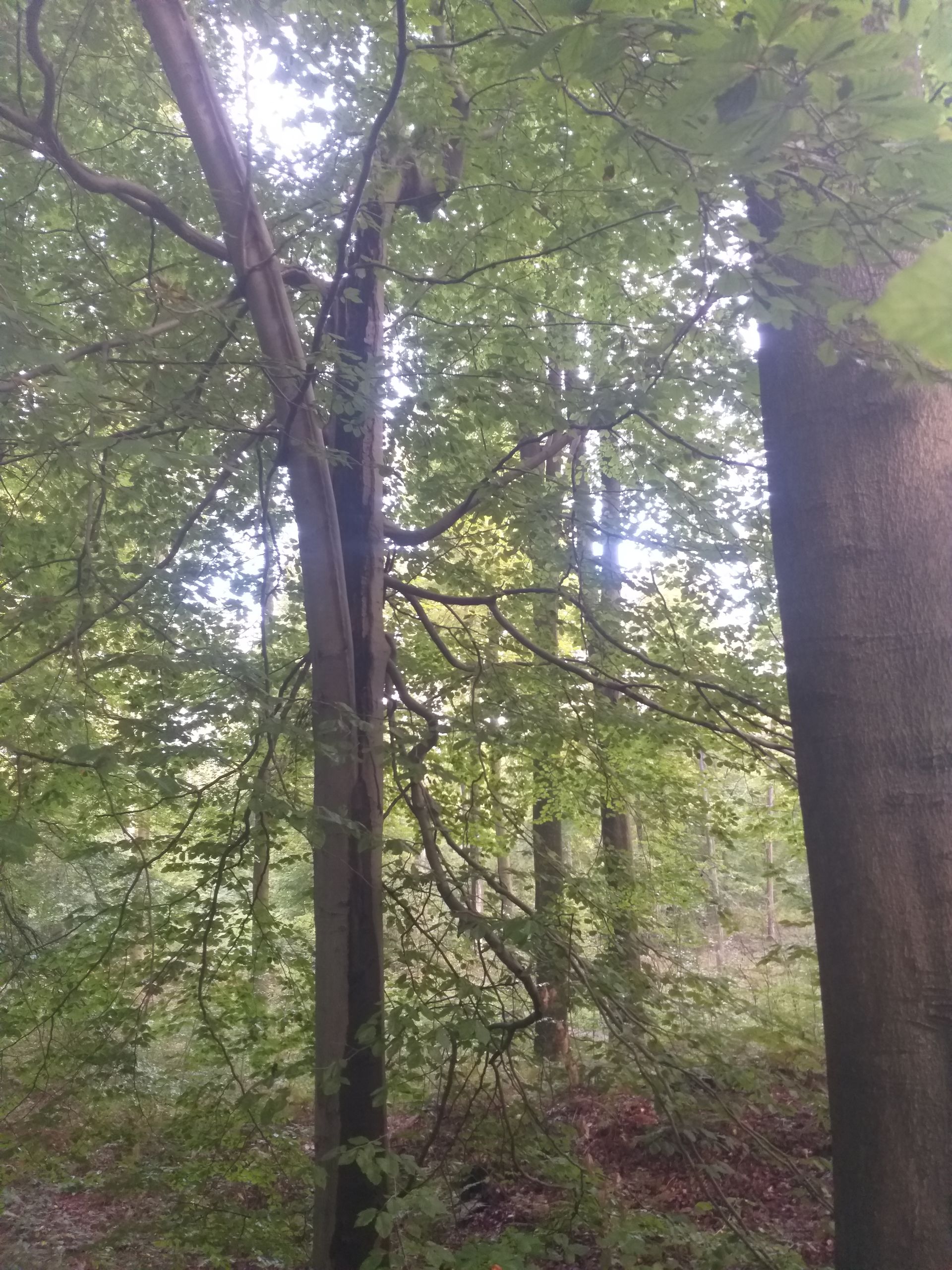
Trees, in fact forests, have an amazing ability to recover and to persevere – when they are given the time to do so, and no one interferes. In the Forêt de Soignes, one of the forests bordering Brussels, there is such a tree, a beech tree, that exemplifies this perseverance to me like no other. Its trunk is split in two up until 2-3 meters above the ground where the roots hit the soil. The inner part of the trunk seems dead but in the outer part of the trunk, the cambium, there is still life and branches with healthy green leaves sprout and extend in every direction. Whenever I pass this beech tree it teaches me a lesson, in fact more than one: Don’t despair. You are stronger than you think you are. Carry on. Life goes on, even after setbacks. Different perhaps, but in ways you could not have imagined before. Try and make the best out of the situation you are in. Count on friendship, ask for and accept help. Community cares and protects. Together, we are stronger. What I haven’t mentioned yet is that this special beech tree stands in the vicinity of a strong, mature tree, also a beech tree. You may be aware that the most interesting things in the forest happen underground, in the soil, the part the eye does not see. The reason why my “perseverance tree” is still alive may be because of the help it received from the nearby beech tree(s) and other agents through a fascinating underground network, known as the mycorrhizal network. Scientists discovered that, simply speaking, trees and fungi (especially mycorrhizal fungi) form a symbiotic relationship with each other. Fungi form complex networks of thread-like structures, called hyphae, which attach to the roots of trees, creating a win-win situation for both sides, as both exchange nutrients through this connection: Trees provide the fungi with carbohydrates (sugars produced during photosynthesis) which fungi cannot produce themselves. In turn, fungi act as an extension of the tree’s root system, providing it with nutrients like nitrogen, phosphorus and micronutrients, thereby increasing the tree’s access to essential minerals. But there’s more to this network than just the exchange of food. The extended root system provided by fungi helps trees to absorb water more efficiently, especially during dry periods. It protects tree roots from infection through harmful microorganisms by creating a protective barrier around them and it also helps trees to communicate with each other. Trees talk to each other? Yes, via chemical signals. These are not just released in the air in the form of phytoncides, creating the typical forest scent. They are also sent via the root network. For example, when a tree is attacked by insects or facing drought it sends signals via the fungal network to neighbouring trees, enabling them to prepare defenses. But this network does not just connect individual trees and fungi. It links multiple plants and even different species of trees together, forming a vast underground network, that scientists have dubbed the ‘internet of the forest’ or the ‘wood-wide web’. Now, while trees are often in competition with each other for sunlight and space, this underground network fosters cooperation and mutual care. It has been discovered that larger, more mature trees, often referred to as mother trees, can share nutrients to younger or weaker trees, helping them to survive in the shaded understory where light is sparce. This sharing and caring strengthens not just the resilience of the weaker trees but benefits the overall interconnectedness of the forest, sustaining the health and diversity of forest ecosystems. So, with this in mind, my ‘perseverance tree’ sets more than one example: Things happen but you can still thrive Every contribution that fosters the well-being of the whole is needed. There needs to be a healthy balance between competition and cooperation for everyone to strive. Diversity is strength. Next time when you walk through a forest, think about all the incredible things that happen beneath your feet. When you walk past a more mature tree, notice the seedlings that grow in his shadow. When you pass by a mushroom, think about how its cap and stem are only the visible part of its larger self and how its hyphae help connecting the forest, ensuring its resilience and health, so it can continue producing the air that all of us breathe. For more information: https://www.youtube.com/watch?v=oVK9TCXZz6I
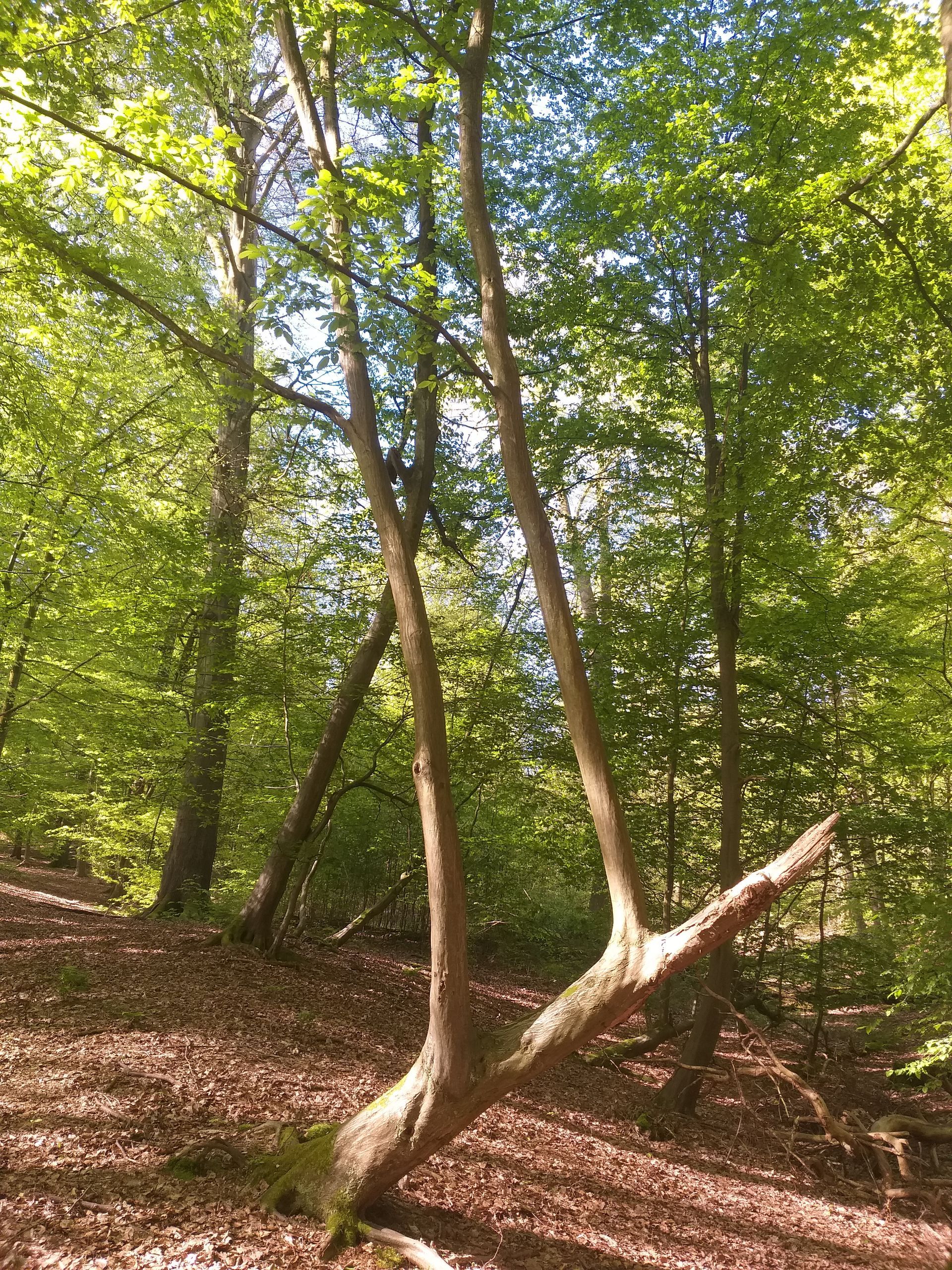
Wenn ich im Wald unterwegs bin, fällt mir die Kraft der Natur immer wieder auf. Und immer wieder ist sie aufs Neue inspirierend und ansteckend. Aus umgefallenen Bäumen, deren Wurzeln teilweise noch in der Erde stecken, sprießen neue Äste, deren Blätter oder Nadeln sich im Frühling wieder entfalten. Aus alten, oft abgestorben geglaubten Stämmen entwickeln sich neue (Seiten)triebe, die mit ihrer jungen Rinde und ihrem frischen Grün einen markanten Kontrast zum knorrigen Stamm bilden. Altes nährt Neues und trägt zu dessen Wachstum bei. Es ist diese unverminderte Lebenskraft, die weiterhin vorhanden ist, wenn auch in anderer Form, und die sich scheinbar nicht aufhalten lässt, die faszinierend ist. Für mich sind diese „Entdeckungen“ immer besonders, da sie an eigene Lebenssituationen erinnern können. Das Leben wirft einen manchmal aus der Bahn oder bringt uns zu Fall und es kostet Kraft, Unterstützung, und nicht selten viel Überwindung und Wille sich wieder aufzuraffen. Es ist oft nicht ganz klar, wie es weitergeht aber es geht weiter und im Nachhinein stellt sich dann heraus, dass es anders gekommen ist, als man dachte. Rückwirkend sind dann zwar Ecken, Kanten und manchmal auch Schrammen entstanden aber auch eine Menge Erfahrung, vielleicht sogar eine Portion Stolz und Zuversicht, dass man sich durch die schwierige Zeit des Übergangs oder des Wandels hindurch navigieren konnte und nicht aufgegeben hat. Auch im Wald sind es eben nicht nur die geraden, hoch aufgewachsenen, scheinbar makellosen Bäume, die zu seiner Schönheit beitragen. Es ist die unzählige Vielfalt in all ihren Besonderheiten und Erscheinungsformen, die zumindest mich in ihren Bann zieht und die jeden Wald einzigartig macht. Denn in ihr zeigt sich die ganze Kraft, Kreativität, Anpassungsfähigkeit und auch das Durchhaltevermögen von Bäumen im Einzelnen und der Natur in ihrer Gesamtheit. Und so ist der Wald nicht nur Inspiration, sondern kann auch Lehrmeister und Vorbild sein in Situationen, die anders laufen als geplant.
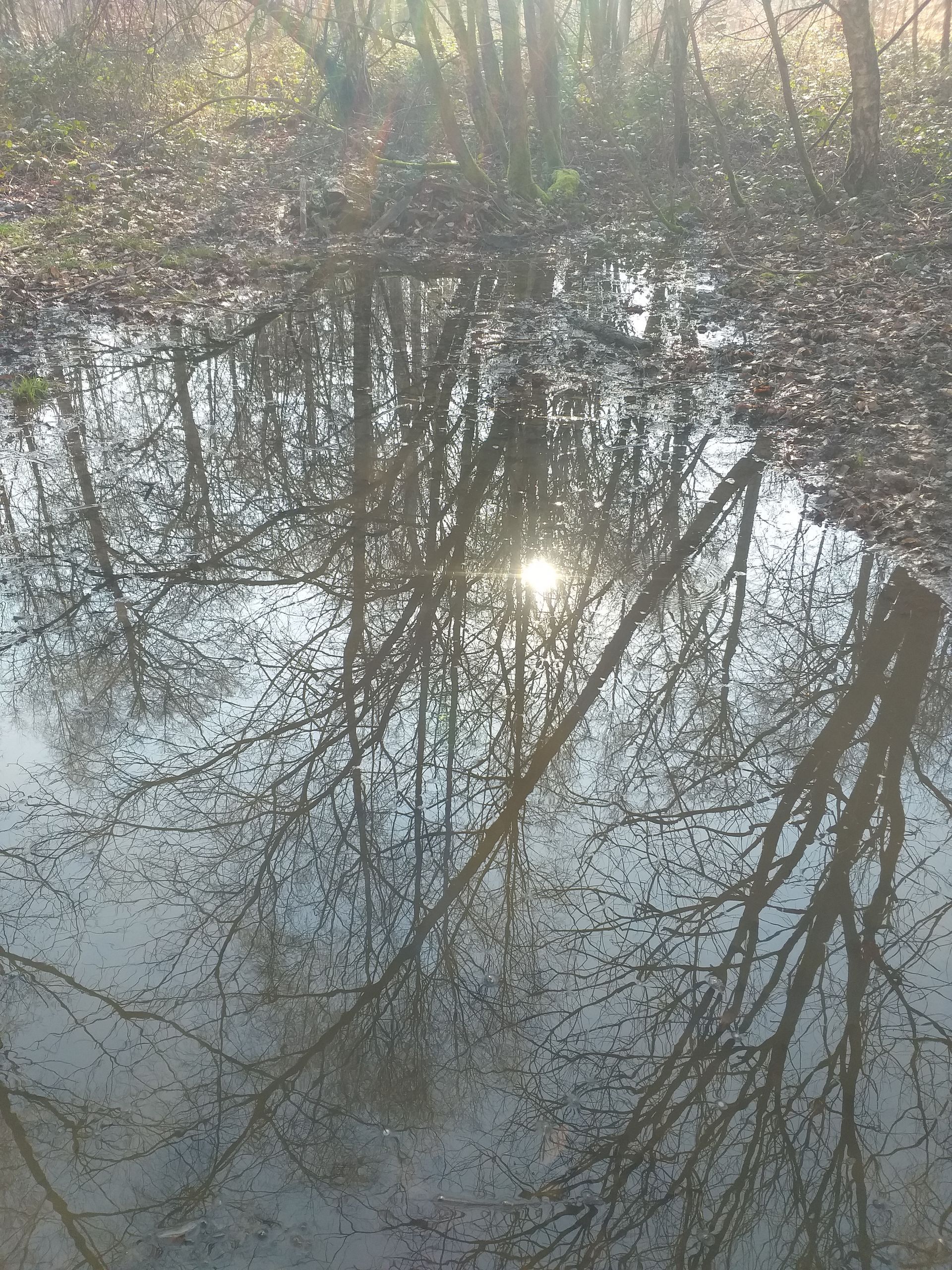
Nach den letzten nassen Tagen, sieht man sie wieder öfter auf den Waldwegen ... Wasserpfützen in allen Größen. Meist gehen wir einfach an ihnen vorüber, ohne sie weiter zu beachten. Das nächste Mal, wenn Sie an einer Wasserpfütze vorbeikommen, nehmen Sie sich ein wenig Zeit. Bleiben Sie davor stehen, schauen Sie hinein, an den Blättern, Stöckchen und Steinen vorbei und lassen Sie sich faszinieren! Es ist, als ob man durch ein Tor in eine andere Welt schaut. Die Bäume, die sich in den Pfützen von unten spiegeln, sehen majestätisch aus. Es fühlt sich an, als ob es auf der anderen Seite der Pfütze unendlich weiter geht und sie erscheint viel größer, als sie auf den ersten Blick aussieht. Reihen sich mehrere Pfützen aneinander ist der Effekt noch einmal größer. Man steht am Rande dieses „Wasserflecks“ und eine ganz neue Perspektive tut sich auf. Je länger man hineinschaut, desto mehr meint man zu entdecken. Die Bäume sehen anders aus, da sie „auf dem Kopf“ stehen. Die Anordnung der Baumkronen und Äste in Verbindung mit den Lichtspielen, die durch die Pfütze noch verstärkt werden, lassen wahre Kunstwerke entstehen. Jede Pfütze, jeder Blick in ihre Weite bietet neue, andere Perspektiven und jede ist für sich spannend – es wird nie langweilig. Wenn Sie das nächste Mal im Wald oder in einem Park unterwegs sind und eine Wasserpfütze sehen, schauen Sie hinein, vergessen Sie die Welt um sich herum für einen Moment und lassen Sie Ihre Gedanken wandern. Sie werden überrascht sein, wie gut selbst dieses kurze Abschalten tut, insbesondere für unser Gehirn, wenn uns die Natur sanft in ihren Bann zieht. Es wird entlastet, kann sich erholen und mentale Ressourcen, wie Konzentrationfähigkeit und Kreativität werden neu aufgeladen,



